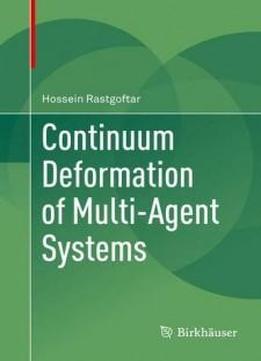
Continuum Deformation Of Multi-agent Systems
by Hossein Rastgoftar /
2016 / English / EPUB
4.8 MB Download
This monograph presents new algorithms for formation control of
multi-agent systems (MAS) based on principles of continuum
mechanics. Beginning with an overview of traditional methods, the
author then introduces an innovative new approach whereby agents
of an MAS are considered as particles in a continuum evolving
in ℝ
This monograph presents new algorithms for formation control of
multi-agent systems (MAS) based on principles of continuum
mechanics. Beginning with an overview of traditional methods, the
author then introduces an innovative new approach whereby agents
of an MAS are considered as particles in a continuum evolving
in ℝn
nwhose desired
configuration is required to satisfy an admissible deformation
function. The necessary theory and its validation on a
mobile-agent-based swarm test bed are considered for two primary
tasks: homogeneous transformation of the MAS and deployment of a
random distribution of agents on a desired
configuration. The framework for this model is based
on homogeneous transformations for the evolution of an MAS under
no inter-agent communication, local inter-agent communication,
and intelligent perception by agents. Different
communication protocols for MAS evolution, the robustness of
tracking of a desired motion by an MAS evolving
in ℝ
whose desired
configuration is required to satisfy an admissible deformation
function. The necessary theory and its validation on a
mobile-agent-based swarm test bed are considered for two primary
tasks: homogeneous transformation of the MAS and deployment of a
random distribution of agents on a desired
configuration. The framework for this model is based
on homogeneous transformations for the evolution of an MAS under
no inter-agent communication, local inter-agent communication,
and intelligent perception by agents. Different
communication protocols for MAS evolution, the robustness of
tracking of a desired motion by an MAS evolving
in ℝn
n, and the effect of communication
delays in an MAS evolving under consensus algorithms or
homogeneous maps are also explored.
, and the effect of communication
delays in an MAS evolving under consensus algorithms or
homogeneous maps are also explored.
Featuring appendices which introduce the requisite concepts from
continuum kinematics and graph theory, this monograph will
provide advanced graduate students and researchers with the
necessary background to understand and apply the methods
presented.
Featuring appendices which introduce the requisite concepts from
continuum kinematics and graph theory, this monograph will
provide advanced graduate students and researchers with the
necessary background to understand and apply the methods
presented.











